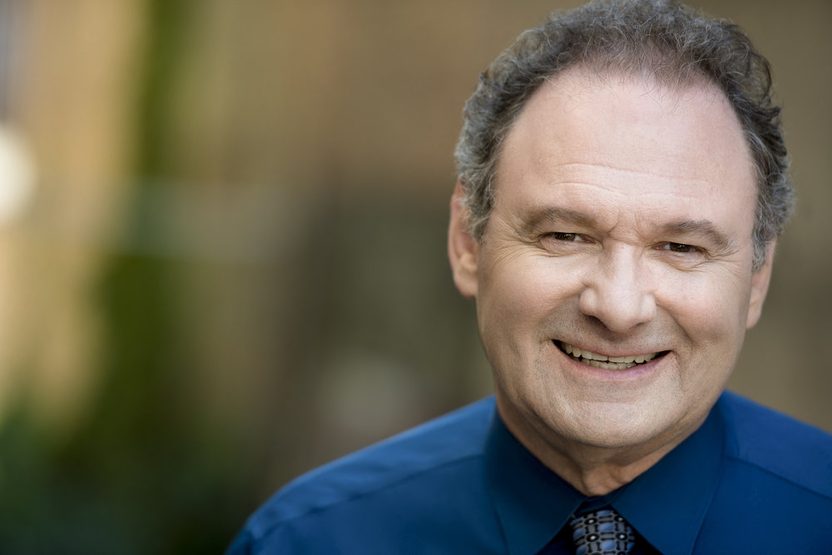In This Story
In this Spotlight, we asked our School of Theater Interim Director, Kevin Murray, to reflect on his 30 years of service at Mason, prior to his upcoming retirement this summer.
“We live in a region that values the arts in education as a strength and not a hobby, and recognizes that the arts build confidence, create critical thinkers and problem-solvers, and contribute exactly what the 21st century workforce is clamoring for. So, the approach hasn’t changed much, but the recognition of its value has grown.”
Looking Back. Murray first joined the university in 1991 at the birth of what would become the Center for the Arts, as an Assistant Director on a production of “One-Third of a Nation,” adapted from the Federal Theater Archives from the 1930s. He reminisces, “At the time, the arts were under the auspices of the new Institute of the Arts; the Concert Hall was concluding its first season; and what is now the School of Theater was known as the Division of Theater, soon to become the Department of Theater and Dance. Lorraine Brown from the English Department had recently unearthed the Federal Theater archives in an old airplane hangar outside Baltimore and brought the collection to Mason. Concurrently, the Institute started a professional theater company in residence, Theater of the First Amendment (TFA), tasked with producing Federal Theater Festivals for several seasons, using plays and projects that had been created in the 1930s under President Roosevelt’s Works Progress Administration. I wore many hats for TFA – Company Manager, Managing Director, Casting Director, Marketing Manager – basically anything that needed doing. It was a small staff and a busy time.”
The Birth of CVPA. Eventually, the Institute of the Arts became the College of Visual and Performing Arts (CVPA); the Theater Division/Department became a School of Theater; and in 2012, after 22 years of producing mostly new world premiere plays for TFA, budget constraints led to the decision to close it down. Murray then moved over to the academic side of things, focusing on the next generation of young theater artists. Throughout those years, the Artistic Director was our own Rick Davis, now Dean of CVPA, who arrived at Mason just a few months after Murray did.
Favorite Experiences. Murray says that he worked with many wonderful artists – playwrights, directors, designers, actors – and learned a lot about the world, past and present, through the many plays TFA produced as well as collaborations with other units. “One of my fondest memories was a collaboration with the Metropolitan Jazz Orchestra from the School of Music; student dancers from the School of Dance; and our own Theater designers in lights and projections, in the creation of To Swing Through the Sky, which explored the twin histories of two American institutions, jazz and flight. I was an onstage narrator for one of the performances at the Hylton Performing Arts Center. To be in the thick of this 40-piece big band blasting live music from the jazz era gave me a thrill I will never forget.”
Challenges. “As with many arts institutions, funding became very tight after the 2008 market crash. We struggled to find enough funding to produce a full season of plays and keep the staff employed. Over time, it was impossible to keep the company afloat. Fortunately, the School of Theater needed someone with my skill set to help recruit new students and organize special programs, so I stepped in. Same office, same people, same pay, same skills, so it worked out very well.”
Arts Education Over the Years. Murray does not think the basic concepts of arts education have changed much. “We live in a region that values the arts in education as a strength and not a hobby, and recognizes that the arts build confidence, create critical thinkers and problem-solvers, and contribute exactly what the 21st century workforce is clamoring for. So, the approach hasn’t changed much, but the recognition of its value has grown.”
Mason’s Position in the Arts World. Murray notes that there are many ways to train young artists, and a lot of institutions that do it well, including the many arts disciplines in CVPA. “I often tell applicants to our program, who are mostly 16 or 17 years old, that there are two schools of thought regarding training – Liberal Arts and Conservatory. Mason is a Liberal Arts University, which means that students are exposed to myriad courses, life experiences, and foundational knowledge that infuse and inspire artists. Conservatories are more structured and immersive, focusing on intense training in the craft. I prefer our way. How can one play a role without general knowledge of how our world works? We draw on our experiences. In addition, we offer two advantages that many other schools do not: (1) We are a part of the cultural region of the metropolitan area, with its 80 professional theaters, many performance venues, museums, etc. What a place to thrive! and (2) We have a faculty of working professionals who not only continue in their craft, but bring those experiences, and sometimes those contacts, back to the classroom. It is a rare opportunity.”
Advice for Graduates. Murray tells graduates, “At first, say yes to as many offers as you can. Build up your network. Perfect your tools of the trade. Continue to take classes. Look at internships and make yourself indispensable, so they are inclined to hire you in the future. Embrace your community of fellow artists.”
As he reflects on his retirement scheduled for this summer, Murray says “I’m gonna miss this place.” We are sure he will be greatly missed.
From Issue #16, Friends of Theater newsletter May 13, 2021

